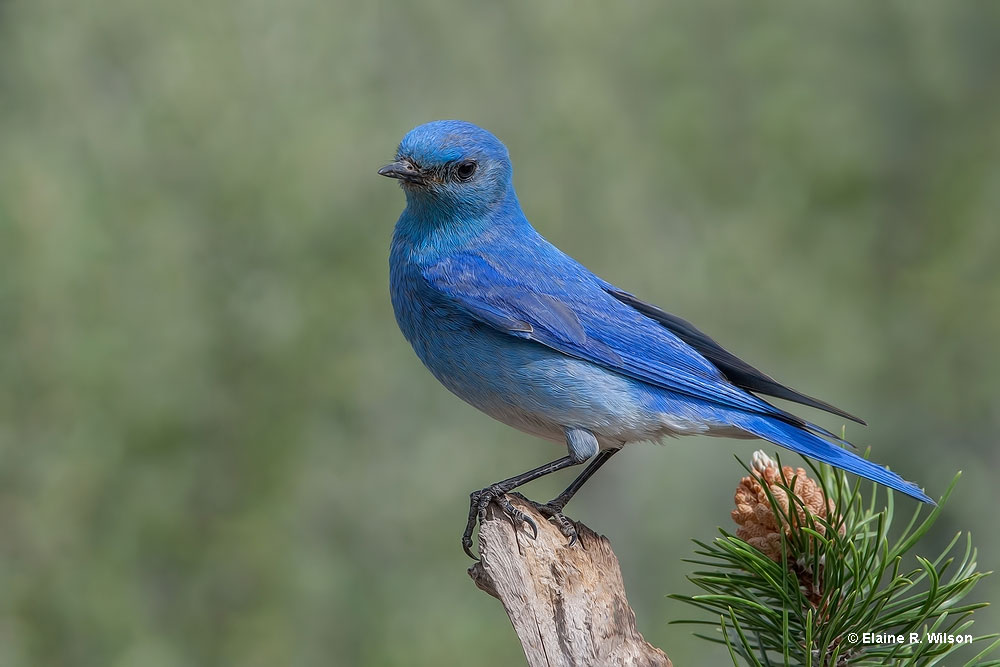
Nevada is a big, scenic western state with 110,577 square miles of deserts, shrublands, marshes, pine forests, and mountains. More than 3,1 million people live in Nevada. They also share space with lots of birds!
Nevada state bird – the beautiful Mountain Bluebird – is one of the most common and beautiful birds of the state. This unmistakable sky-blue and gray thrush is a common bird throughout Nevada.
On this page
State Bird of Nevada
The Mountain Bluebird became the official state bird of Nevada in 1967. Not long before that date, Clark County Assemblyman Stan Irwin had introduced a bill to declare this species as the state bird. Nevada State Legislature quickly voted to approve his bill, and Governor Paul Laxalt signed it on April 4th of that same year.
Although Nevada made it official in 1967, people in the state had actually already picked the Mountain Bluebird several years before then.
In 1930, in common with most other states at that time, the local Federation of Women’s Clubs campaigned for Nevada to choose a bird that would best represent the state.
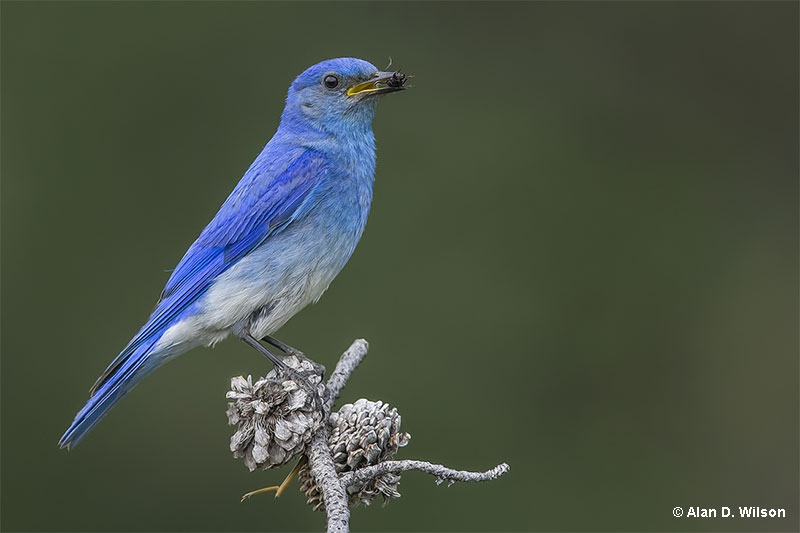
They suggested the lovely Mountain Bluebird, and schoolchildren in Nevada voted to pick this species.
However, the Mountain Bluebird didn’t become the official bird for the state until Stan Irwin presented his bill to the state legislature in 1967.
Folks in Nevada picked this bird because it is a such a lovely and common species. Although impressive birds like the Golden Eagle, Prairie Falcon, and Sandhill Crane also occur in Nevada, they aren’t as common, nor as beautiful as the Mountain Bluebird.
In most parts of Nevada, it’s hard not to notice these striking blue birds as they perch and fly over the state’s scenic landscapes.
Fun Facts about Mountain Bluebirds
- Mountains Bluebirds are special birds for several indigenous cultures in the western USA. Their blue colors resemble turquoise, a beautiful stone that has an important place in western indigenous cultures.
- This species is in the thrush family. Despite looking different from them, it is related to birds like the American Robin, Swainson’s Thrush, and the Varied Thrush.
- Mountain Bluebirds have long wings to help them move long distances in the open habitats where they occur. These small birds can fly as fast as 45 miles per hour!
- The Mountain Bluebird lives further north than the other two bluebird species. It even breeds in Alaska and is sometimes also called Arctic Bluebird.
- This species can hybridize with the Eastern Bluebird. Once in a while, these two different species form pairs with each other. They can have young, but their offspring probably can’t survive as well as their parents.
- The Mountain Bluebird has very good vision. They can notice an insect 300 feet away!
- Mountains Bluebirds are a species of cold and windy places. Their dense, beautiful plumage protects them from colder weather than other bluebirds.
Identification
The Mountain Bluebird is a small bird larger than a sparrow but smaller than an American Robin. Males and females have dark eyes, a slender, black beak, and longish, black legs. These thrushes also have long wings and a medium-length tail.
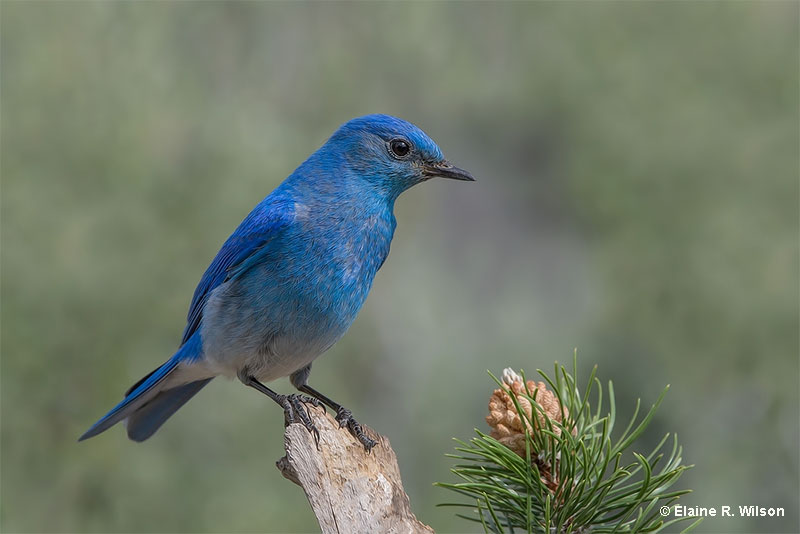
Males have lovely cerulean or sky blue plumage with a hint of a narrow gray eyering, a white belly, and a white undertail. In bright sun, their blue colors can look glossy.
The males are also a little bit bigger than female bluebirds, but their size difference is very hard to notice.
Female Mountain Bluebirds are mostly plumaged in pale gray, and have a white belly and undertail. They also have a more obvious pale eyering broader on the back part of the eye.
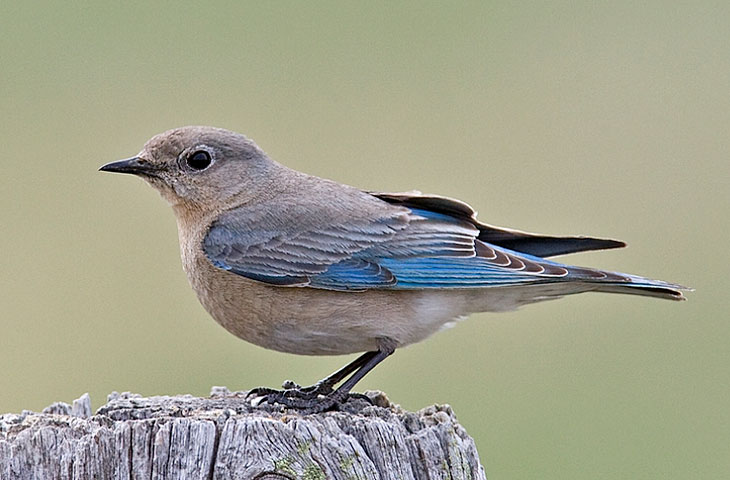
Female Mountain Bluebird
These elegant thrushes also have blue in their wings, on their rump, and on their tail. Some females can show reddish-brown on their breast and back.
In flight, the Mountain Bluebird is a fast and graceful bird that can quickly bound overhead before swooping down to bushes, small trees, or the ground. Sometimes, we also see these birds hovering above the ground.
The male Mountain Bluebird is easily recognized by its sky-blue plumage. Females are recognized by their sky blue wings and tail, pale chin, narrow dark beak, and broken pale eyering.
What do Mountain Bluebirds eat?
Mountain Bluebirds mostly eat insects in open habitats, usually in areas with short grass. They mostly forage by waiting on a perch and then flying down to the ground to snatch the creature with their beak.
They also catch insects by snatching them in flight, and by picking up bugs as they hop on the ground. This bluebird species also hovers before flying down to catch prey, and can fly to vegetation to pick bugs from foliage.
The Mountain Bluebird feeds on most any insect they can catch including flies, beetles, and caterpillars.
In winter, this thrush species also feeds on small fruits and seeds but still prefers insects. When feeding on berries, they pick them while perched.
Call
Mountain Bluebirds makes pleasant, brief calls. They often make a descending “feew” or “peeer” call that sounds similar to vocalizations of other bluebird species. However, Mountain Bluebird calls are clearer and “thinner”.
The Mountain Bluebird also commonly makes a short and harsh “check” call.
Both sexes make these vocalizations but males also sing a complex song of four or seven brief phrases. The notes are a burry and sound like, “brif peeruh prif peeruh prif”.
Behavior
Mountain Bluebirds spend a lot of their time watching for insects from a suitable perch in open places. We also see them hopping and hovering above the ground.
Like other bluebird species, the Mountain Bluebird nests in cavities. It uses old woodpecker holes but can also use nest boxes. During the nesting season, pairs defend a territory but flock with other bluebirds during fall and winter.
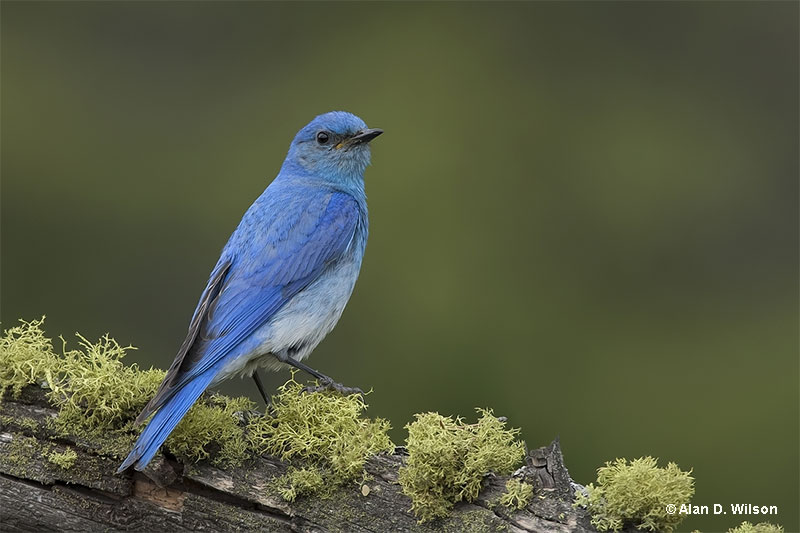
This species breeds in Alaska, western Canada, and the western USA, and winters in the western USA and northern Mexico.
Mountain Bluebirds don’t pose any threat to people or pets. However, they do have to watch out for various predators. They are preyed on by raptors such as the Sharp-shinned Hawk, Cooper’s Hawk, Prairie Falcon, and other birds, including owls.
Nestling bluebirds are also susceptible to being caught by magpies, crows, and small mammals.
Nevada State Bird: Frequently Asked Questions
What is the state bird of Nevada?
The state bird of Nevada is the Mountain Bluebird. This species is commonly seen and heard throughout the state.
How many bird species are in Nevada?
There are 493 bird species in Nevada. According to the official bird list for Nevada, 493 birds have been found in the state.
What is the rarest bird in Nevada?
The rarest bird in Nevada is the Black Rosy-Finch. This species can be seen in various parts of the state but it is declining and endangered with extinction. The near-threatened Ridgeway’s Rail is another rare bird that lives in Nevada while the rarest bird sighting in the state may have been a vagrant Eastern Yellow Wagtail seen in Las Vegas in 1994.
What birds is Nevada known for?
Nevada is known for western birds of desert and open habitats. These are species like the Cinnamon Teal, Gambel’s Quail, and the Say’s Phoebe.

